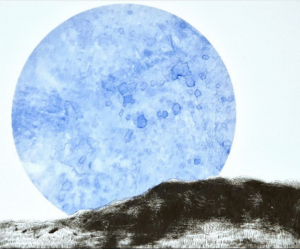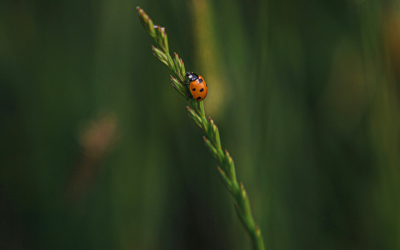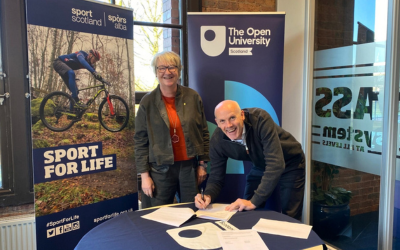The Moon, Scots language and the Scottish landscape
 Author:
Author:
Dr Sylvia Warnecke is Associate Head of School Students and Nations at the Open University’s School of Languages and Applied Linguistics.
The moon's special place in Scotland’s culture, as reflected in numerous traditions, works of art and proverbial sayings, is explored by Dr Sylvia Warnecke from the Open University’s School of Languages and Applied Linguistics.
The people of Scotland have spoken, written and sung about the moon not only in English but also in Scotland’s two indigenous languages Gaelic and Scots.
It is fascinating that in both Gaelic and Scots languages distinct aspects of the moon have played a part in naming this celestial object.
The Scottish Gaelic word for moon is ‘a’ ghealach’, derived from the Latin ‘lūna’; light that illuminates the darkness.
Whereas in Scots, ‘mune’ is related to the regularly changing shape of the moon; something people were not only fascinated by but used it to measure time.
 Mune can be traced back to the Old English ‘mōna’, with its origins in the Latin ‘metri,’ to measure, and ‘mensis’, month. In Scots, a non-standardised language, mune has different spellings (e.g., mön, müne, muin, meen, min, mon) depending on the local dialect.
Mune can be traced back to the Old English ‘mōna’, with its origins in the Latin ‘metri,’ to measure, and ‘mensis’, month. In Scots, a non-standardised language, mune has different spellings (e.g., mön, müne, muin, meen, min, mon) depending on the local dialect.
Mune features in ample customs and sayings across Scotland. For example, a ‘meenlichtie’, literally ‘moon light money’, was used in Aberdeen to describe a due paid by fishermen for permission to fish for herring in the North Sea during the second or third quarters of the moon.
Different shapes and positions of the moon are used to predict weather. Rain is forecast when the ‘new mone lies sair on her back, or when her horns are pointed towards the zenith’.
Accordingly, the proverb ‘The bonny meen is on her back, Mend your sheen and sort your thack!’ advises people to fix their lamps and thatched roofs before the rain comes.
In Orkney and Shetland fishermen speak of a ‘müne brough’ or ‘mon broch’, a bright halo around the moon, as a warning of stormy weather. The halo – broch – is borrowed from the round shape of prehistoric dwellings still present in these isles.
In Dumfriesshire Scotland’s national bard Robert Burns wrote a poem in Scots praising the beauty and sense of peace that moonshine evokes:
The Night Was Still, by Robert Burns, 1786
The night was still, and o'er the hill
The moon shone on the castle wa'
The mavis sang, while dew-drops hang
Around her on the castle wa'.
What Burns describes - the moon appearing over the Scottish hills - is a vision which has captivated contemporary Scottish print artist Nicola McInally.
McInally explains her fascination with the moon from her childhood in a superstitious household where she would often be told not to look at the moon, which made it all the more mysterious and alluring to her.
This superstition is captured in the Scots proverb ‘Ye'll be gettin' yer face in the mune’, warning people of the fate of the man in the moon who was supposed to have been banished there for gathering sticks on Sunday thus breaking a sacred rule.
What’s not to like about our brightest companion in the night sky!”
Nicola McInally, Artist
McInally visualises the contrast between the calm and the dramatic landscapes of Scotland as shaped by nature. The mystery of the blue moon in her artwork Blue Moon I’ve Yet To See (pictured) comes from the Scots word ‘belewe’; a symbol of hope and anticipation. Observing the varying shades and shapes of the mune, from the pink ‘hairst mune’ to ‘the auld mune in the airm(s) o' the new’ inspired McInally’s Lunar Love print series, on which she comments:
“The moon is a constant and the relationship between the moon and the surrounding Scottish landscape is ever-evolving. I enjoy the calming influence of the full moon - this lone familiar celestial orb - and I try to recreate the same calmness through the colour palette of my artwork.
“What’s not to like about our brightest companion in the night sky!”.
The Open University (OU) is co-hosting the European Lunar Symposium in Dumfries 16-21 June, plus accompanying public Solstice Seminars with lunar exploration experts, on the evening of Thursday 20 June 2024.
The OU offers the free online introductory-level short courses Gaelic in modern Scotland and Scots language and culture, and a collection of free resources about Moons. There is also an OU Scots language professional learning programme for teachers.
Image: Nicola McInally, Blue Moon I’ve Yet To See, 2023
17 June 2024
News
Media contacts
Media enquiries
OU in Scotland Media Relations:
Call 0131 549 7932
OU UK Press Office:
Call 01908 654316
Out-of-hours:
07901 515 891
Visit our OU UK news site

